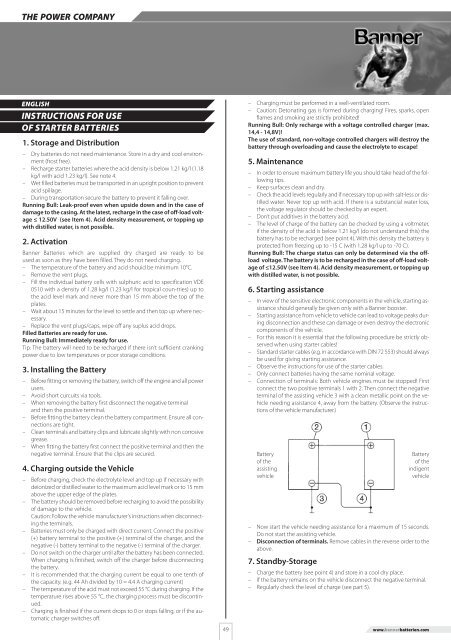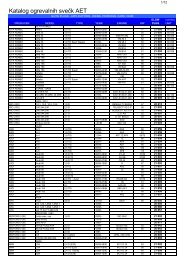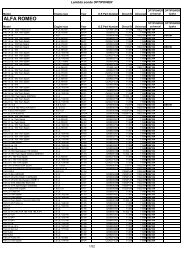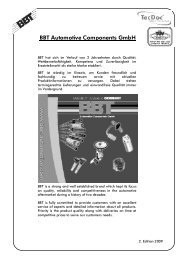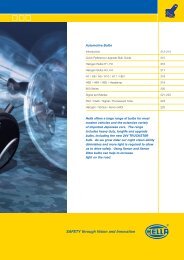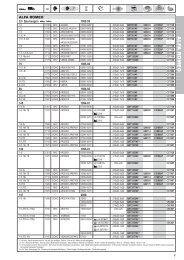www.bannerbatterien.com WESTEUROPA / WESTERN EUROPE
www.bannerbatterien.com WESTEUROPA / WESTERN EUROPE
www.bannerbatterien.com WESTEUROPA / WESTERN EUROPE
Create successful ePaper yourself
Turn your PDF publications into a flip-book with our unique Google optimized e-Paper software.
THE POWER COMPANY<br />
ENGLISH<br />
INSTRUCTIONS FOR USE<br />
OF STARTER BATTERIES<br />
1. Storage and Distribution<br />
– Dry batteries do not need maintenance. Store in a dry and cool environment<br />
(frost free).<br />
– Recharge starter batteries where the acid density is below 1.21 kg/l (1.18<br />
kg/l with acid 1.23 kg/l). See note 4.<br />
– Wet filled batteries must be transported in an upright position to prevent<br />
acid spillage.<br />
– During transportation secure the battery to prevent it falling over.<br />
Running Bull: Leak-proof even when upside down and in the case of<br />
damage to the casing. At the latest, recharge in the case of off-load voltage<br />
≤ 12.50V (see Item 4). Acid density measurement, or topping up<br />
with distilled water, is not possible.<br />
2. Activation<br />
Banner Batteries which are supplied dry charged are ready to be<br />
used as soon as they have been filled. They do not need charging.<br />
– The temperature of the battery and acid shouid be minimum 10°C.<br />
– Remove the vent plugs.<br />
– Fill the individual battery cells with sulphuric acid to specification VDE<br />
0510 with a density of 1.28 kg/l (1.23 kg/l for tropical coun-tries) up to<br />
the acid level mark and never more than 15 mm above the top of the<br />
plates.<br />
– Wait about 15 minutes for the level to settle and then top up where necessary.<br />
– Replace the vent plugs/caps, wipe off any suplus acid drops.<br />
Filled Batteries are ready for use.<br />
Running Bull: Immediately ready for use.<br />
Tip: The battery will need to be recharged if there isn’t sufficient cranking<br />
power due to low temperatures or poor storage conditions.<br />
3. Installing the Battery<br />
– Before fitting or removing the battery, switch off the engine and all power<br />
users.<br />
– Avoid short curcuits via tools.<br />
– When removing the battery first disconnect the negative terminal<br />
and then the positive terminal.<br />
– Before fitting the battery clean the battery <strong>com</strong>partment. Ensure all connections<br />
are tight.<br />
– Clean terminals and battery clips and lubricate slightly with non corrosive<br />
grease.<br />
– When fitting the battery first connect the positive terminal and then the<br />
negative terminal. Ensure that the clips are secured.<br />
4. Charging outside the Vehicle<br />
– Before charging, check the electrolyte level and top up if necessary with<br />
deionized or distilled water to the maximum acid level mark or to 15 mm<br />
above the upper edge of the plates.<br />
– The battery should be removed before recharging to avoid the possibility<br />
of damage to the vehicle.<br />
Caution: Follow the vehicle manufacturer’s instructions when disconnecting<br />
the terminals.<br />
– Batteries must only be charged with direct current. Connect the positive<br />
(+) battery terminal to the positive (+) terminal of the charger, and the<br />
negative (-) battery terminal to the negative (-) terminal of the charger.<br />
– Do not switch on the charger until after the battery has been connected.<br />
When charging is finished, switch off the charger before disconnecting<br />
the battery.<br />
– It is re<strong>com</strong>mended that the charging current be equal to one tenth of<br />
the capacity. (e.g. 44 Ah divided by 10 = 4.4 A charging current)<br />
– The temperature of the acid must not exceed 55 °C during charging. If the<br />
temperature rises above 55 °C, the charging process must be discontinued.<br />
– Charging is finished if the current drops to 0 or stops falling, or if the automatic<br />
charger switches off.<br />
49<br />
– Charging must be performed in a well-ventilated room.<br />
– Caution: Detonating gas is formed during charging! Fires, sparks, open<br />
flames and smoking are strictly prohibited!<br />
Running Bull: Only recharge with a voltage controlled charger (max.<br />
14,4 - 14,8V)!<br />
The use of standard, non-voltage controlled chargers will destroy the<br />
battery through overloading and cause the electrolyte to escape!<br />
5. Maintenance<br />
– In order to ensure maximum battery life you should take head of the following<br />
tips.<br />
– Keep surfaces clean and dry.<br />
– Check the acid levels regularly and if necessary top up with salt-less or distilled<br />
water. Never top up with acid. If there is a substancial water loss,<br />
the voltage regulator should be checked by an expert.<br />
– Don’t put additives in the battery acid.<br />
– The level of charge of the battery can be checked by using a voltmeter,<br />
if the density of the acid is below 1.21 kg/l (do not understand this) the<br />
battery has to be recharged (see point 4). With this density the battery is<br />
protected from freezing up to -15 C (with 1.28 kg/l up to -70 C).<br />
Running Bull: The charge status can only be determined via the offload<br />
voltage. The battery is to be recharged in the case of off-load voltage<br />
of ≤12.50V (see Item 4). Acid density measurement, or topping up<br />
with distilled water, is not possible.<br />
6. Starting assistance<br />
– In view of the sensitive electronic <strong>com</strong>ponents in the vehicle, starting assistance<br />
should generally be given only with a Banner booster.<br />
– Starting assistance from vehicle to vehicle can lead to voltage peaks during<br />
disconnection and these can damage or even destroy the electronic<br />
<strong>com</strong>ponents of the vehicle.<br />
– For this reason it is essential that the following procedure be strictly observed<br />
when using starter cables!<br />
– Standard starter cables (e.g. in accordance with DIN 72 553) should always<br />
be used for giving starting assistance.<br />
– Observe the instructions for use of the starter cables.<br />
– Only connect batteries having the same nominal voltage.<br />
– Connection of terminals: Both vehicle engines must be stopped! First<br />
connect the two positive terminals 1 with 2. Then connect the negative<br />
terminal of the assisting vehicle 3 with a clean metallic point on the vehicle<br />
needing assistance 4, away from the battery. (Observe the instructions<br />
of the vehicle manufacturer.)<br />
Battery<br />
of the<br />
assisting<br />
vehicle<br />
– Now start the vehicle needing assistance for a maximum of 15 seconds.<br />
Do not start the assisting vehicle.<br />
– Disconnection of terminals. Remove cables in the reverse order to the<br />
above.<br />
7. Standby-Storage<br />
Battery<br />
of the<br />
indigent<br />
vehicle<br />
– Charge the battery (see point 4) and store in a cool dry place.<br />
– If the battery remains on the vehicle disconnect the negative terminal.<br />
– Regularly check the level of charge (see part 5).<br />
<strong>www</strong>.<strong>bannerbatterien</strong>.<strong>com</strong>


